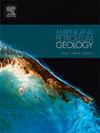How marine incursions affect the sedimentary environment and the quality of source rocks in the Upper Cretaceous Songliao Basin, NE China
IF 3.7
2区 地球科学
Q1 GEOSCIENCES, MULTIDISCIPLINARY
引用次数: 0
Abstract
The linkage between marine incursions and lacustrine petroleum source rock deposition has been studied worldwide. A variety of interpretations have been suggested to explain the influence of marine incursions on the quality of source rocks in the Upper Cretaceous Qingshankou Formation (K2qn), Songliao Basin. In this study, high-resolution of geochemical and sedimentary results of two drilled wells from the K2qn were presented to improve the understanding on this issue. 117 samples from Well GY8HC of the Qijia-Gulong Sag (brief as Gulong Sag) and 251 samples from Well ZY1 of the Sanzhao Sag, the Central Depression of the basin were analyzed to establish the evolution of paleoenvironment and the influence of marine incursions on organic matter enrichment in the two sags. All the evidence suggests that marine incursions have a positive effect on the quality of member 1 of the K2qn source rocks (K2qn1) in the Sanzhao Sag, which was probably due to the rising lake level and increasing salinity of the watermasses. The enhanced salinities could have inhibited lake overturn and oxygenation of bottom water, and thus created a favorable condition for the preservation of organic matter. In contrast, the K2qn1 source rock in the Gulong Sag was less affected by marine incursions, which is likely due to the Daqing placanticline blocking two sags. The lake water in the Gulong Sag was characterized as fresh-brackish with less mixing of seawater. Petrographic observation suggests that organic matter in the Gulong source rocks was mainly derived from lacustrine algal and microsporinite. This research provides novel insights into the linkage between marine incursions and the depositional environment during the formation of K2qn1 in the Songliao Basin.
海洋入侵如何影响中国东北上白垩统松辽盆地的沉积环境和源岩质量
全世界都在研究海侵与湖相石油源岩沉积之间的联系。为解释海侵对松辽盆地上白垩统青山口组(K2qn)源岩质量的影响,人们提出了多种解释。本研究介绍了 K2qn 地区两口钻井的高分辨率地球化学和沉积结果,以加深对这一问题的理解。该研究分析了盆地中央凹陷齐家-古龙套(简称古龙套)GY8HC井的117个样品和三兆套ZY1井的251个样品,以确定古环境的演变以及海洋入侵对两个套内有机质富集的影响。所有证据都表明,海侵对三赵沙沟K2qn源岩1(K2qn1)的质量有积极影响,这可能是由于湖泊水位上升和水体盐度增加造成的。盐度的升高可能抑制了湖水的翻腾和底层水的含氧量,从而为有机质的保存创造了有利条件。相比之下,古龙断陷中的 K2qn1 源岩受海洋入侵的影响较小,这可能是由于大庆海盆线阻隔了两个断陷。古龙脉的湖水特征为淡-咸水混合,海水混入较少。岩相观察表明,古龙源岩中的有机质主要来源于湖相藻类和微孢子岩。该研究为松辽盆地K2qn1形成过程中海洋入侵与沉积环境之间的联系提供了新的见解。
本文章由计算机程序翻译,如有差异,请以英文原文为准。
求助全文
约1分钟内获得全文
求助全文
来源期刊

Marine and Petroleum Geology
地学-地球科学综合
CiteScore
8.80
自引率
14.30%
发文量
475
审稿时长
63 days
期刊介绍:
Marine and Petroleum Geology is the pre-eminent international forum for the exchange of multidisciplinary concepts, interpretations and techniques for all concerned with marine and petroleum geology in industry, government and academia. Rapid bimonthly publication allows early communications of papers or short communications to the geoscience community.
Marine and Petroleum Geology is essential reading for geologists, geophysicists and explorationists in industry, government and academia working in the following areas: marine geology; basin analysis and evaluation; organic geochemistry; reserve/resource estimation; seismic stratigraphy; thermal models of basic evolution; sedimentary geology; continental margins; geophysical interpretation; structural geology/tectonics; formation evaluation techniques; well logging.
 求助内容:
求助内容: 应助结果提醒方式:
应助结果提醒方式:


